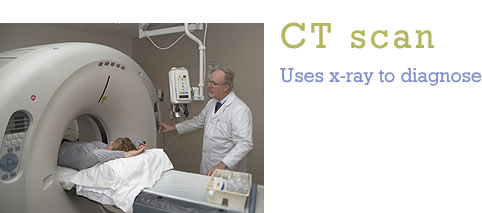Health Tips - CT Scan

CT stands for “Computerized Tomography.” “Tomos” is Greek for “section, slice.” In a CT scan machine, an x-ray tube rotates around a patient laying on a table. The x-ray radiates around the body at different angles, in cross sections or "slices" of that patient. A detector receives the radiation that passes through the patient, and sends it to a computer to form an image of the body’s insides.
Pros
A CT scan is excellent for diagnosing muscle and bone disorders, such as bone tumors and fractures. It helps pinpoint the location of a tumor or blood clot. This scan is an excellent way to quickly locate internal injuries from an accident. It can make the brain visible and, with the help of injected contrast dye, can check for blockages or other problems in your blood vessels. It is used to guide procedures such as surgery, biopsy, and radiation therapy.
Cons
The radiation exposure a patient receives from a full-body CT scan is often 500 times more than that of a regular x-ray. The radiation exposure from a full-body scan is similar to standing 1.5 miles away from the World War II atomic bomb blasts in Japan.
Radiation exposure increases the risk of developing cancer, especially for children.
The injected contrast dye, containing barium or iodine, can, in rare instances, result in severe allergic reactions. The contrast material can also result in kidney damage in patients who have kidney conditions or diabetes.
When you agree to have a CT scan, it is your job to make sure that it is necessary and worth any potential risk.
Read my tip Hospital Tests to find a few suggestions on how to reduce the physical stress from a CT scan. If you, or someone you know, is considering surgery for a condition, please read my success stories from patients to see if your condition is one I can offer a natural solution for. Or, read my program for health results.
Dr. Pepi
September 10, 2010
